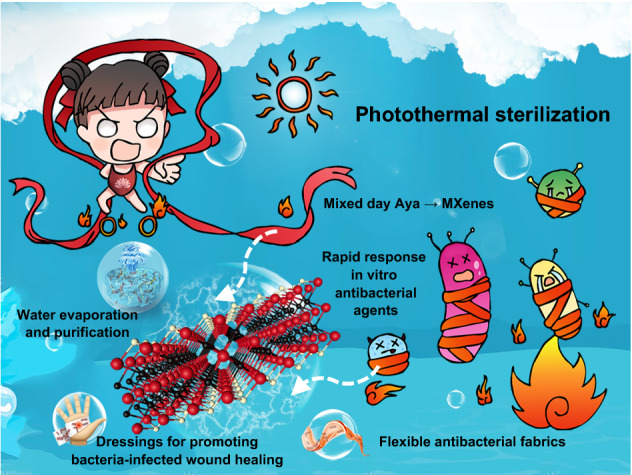- Record: found
- Abstract: found
- Article: found
Recent Advancements on Photothermal Conversion and Antibacterial Applications over MXenes-Based Materials

Read this article at
Abstract
Highlights
-
Fabrication, characterizations and photothermal properties of MXenes are systematically described.
-
Photothermal-derived antibacterial performances and mechanisms of MXenes-based materials are summarized and reviewed.
-
Recent advances in the derivative applications relying on antibacterial properties of MXenes-based materials, including in vitro and in vivo sterilization, solar water evaporation and purification, and flexible antibacterial fabrics, are investigated.
Abstract
The pernicious bacterial proliferation and emergence of super-resistant bacteria have already posed a great threat to public health, which drives researchers to develop antibiotic-free strategies to eradicate these fierce microbes. Although enormous achievements have already been achieved, it remains an arduous challenge to realize efficient sterilization to cut off the drug resistance generation. Recently, photothermal therapy (PTT) has emerged as a promising solution to efficiently damage the integrity of pathogenic bacteria based on hyperthermia beyond their tolerance. Until now, numerous photothermal agents have been studied for antimicrobial PTT. Among them, MXenes (a type of two-dimensional transition metal carbides or nitrides) are extensively investigated as one of the most promising candidates due to their high aspect ratio, atomic-thin thickness, excellent photothermal performance, low cytotoxicity, and ultrahigh dispersibility in aqueous systems. Besides, the enormous application scenarios using their antibacterial properties can be tailored via elaborated designs of MXenes-based materials. In this review, the synthetic approaches and textural properties of MXenes have been systematically presented first, and then the photothermal properties and sterilization mechanisms using MXenes-based materials are documented. Subsequently, recent progress in diverse fields making use of the photothermal and antibacterial performances of MXenes-based materials are well summarized to reveal the potential applications of these materials for various purposes, including in vitro and in vivo sterilization, solar water evaporation and purification, and flexible antibacterial fabrics. Last but not least, the current challenges and future perspectives are discussed to provide theoretical guidance for the fabrication of efficient antimicrobial systems using MXenes.

Related collections
Most cited references160
- Record: found
- Abstract: not found
- Article: not found
Two-dimensional nanocrystals produced by exfoliation of Ti3 AlC2.
- Record: found
- Abstract: not found
- Article: not found
2D metal carbides and nitrides (MXenes) for energy storage
- Record: found
- Abstract: found
- Article: not found